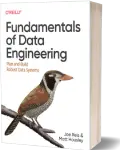Fundamentals of Data Engineering
Data Science
Book Details
Book Title
Fundamentals of Data Engineering
Author
Joe Reis; Matt Housley
Publisher
O'Reilly Media, Inc
Publication Date
2022
ISBN
9781098108304
Number of Pages
636
Language
English
Format
File Size
8.9MB
Subject
Data science
Table of Contents
- Preface
- I. Foundation and Building Blocks
- Chapter 1: Data Engineering Described
- What Is Data Engineering?
- Data Engineering Skills and Activities
- Data Engineers Inside an Organization
- Conclusion
- Additional Resources
- Chapter 2: The Data Engineering Lifecycle
- What Is the Data Engineering Lifecycle?
- Major Undercurrents Across the Data Engineering Lifecycle
- Conclusion
- Additional Resources
- Chapter 3: Designing Good Data Architecture
- What Is Data Architecture?
- Principles of Good Data Architecture
- Major Architecture Concepts
- Examples and Types of Data Architecture
- Who’s Involved with Designing a Data Architecture?
- Conclusion
- Additional Resources
- Chapter 4: Choosing Technologies Across the Data Engineering Lifecycle
- Team Size and Capabilities
- Speed to Market
- Interoperability
- Cost Optimization and Business Value
- Today Versus the Future: Immutable Versus Transitory Technologies
- Location
- Build Versus Buy
- Monolith Versus Modular
- Serverless Versus Servers
- Optimization, Performance, and the Benchmark Wars
- Undercurrents and Their Impacts on Choosing Technologies
- Conclusion
- Additional Resources
- II. The Data Engineering Lifecycle in Depth
- Chapter 5: Data Generation in Source Systems
- Sources of Data: How Is Data Created?
- Source Systems: Main Ideas
- Source System Practical Details
- Whom You’ll Work With
- Undercurrents and Their Impact on Source Systems
- Conclusion
- Additional Resources
- Chapter 6: Storage
- Raw Ingredients of Data Storage
- Data Storage Systems
- Data Engineering Storage Abstractions
- Big Ideas and Trends in Storage
- Whom You’ll Work With
- Undercurrents
- Conclusion
- Additional Resources
- Chapter 7: Ingestion
- What Is Data Ingestion?
- Key Engineering Considerations for the Ingestion Phase
- Batch Ingestion Considerations
- Message and Stream Ingestion Considerations
- Ways to Ingest Data
- Whom You’ll Work With
- Undercurrents
- Conclusion
- Additional Resources
- Chapter 8: Queries, Modeling, and Transformation
- Queries
- Data Modeling
- Transformations
- Whom You’ll Work With
- Undercurrents
- Conclusion
- Additional Resources
- Chapter 9: Serving Data for Analytics, Machine Learning, and Reverse ETL
- General Considerations for Serving Data
- Analytics
- Machine Learning
- What a Data Engineer Should Know About ML
- Ways to Serve Data for Analytics and ML
- Reverse ETL
- Whom You’ll Work With
- Undercurrents
- Conclusion
- Additional Resources
- III. Security, Privacy, and the Future of Data Engineering
- Chapter 10: Security and Privacy
- People
- Processes
- Technology
- Conclusion
- Additional Resources
- Chapter 11: The Future of Data Engineering
- The Data Engineering Lifecycle Isn’t Going Away
- The Decline of Complexity and the Rise of Easy-to-Use Data Tools
- The Cloud-Scale Data OS and Improved Interoperability
- “Enterprisey” Data Engineering
- Titles and Responsibilities Will Morph...
- Moving Beyond the Modern Data Stack, Toward the Live Data Stack
- Conclusion
- Appendix A: Serialization and Compression Technical Details
- Serialization Formats
- Database Storage Engines
- Compression: gzip, bzip2, Snappy, Etc.
- Appendix B: Cloud Networking
- Cloud Network Topology
- CDNs
- The Future of Data Egress Fees
- Index
- About the Authors
